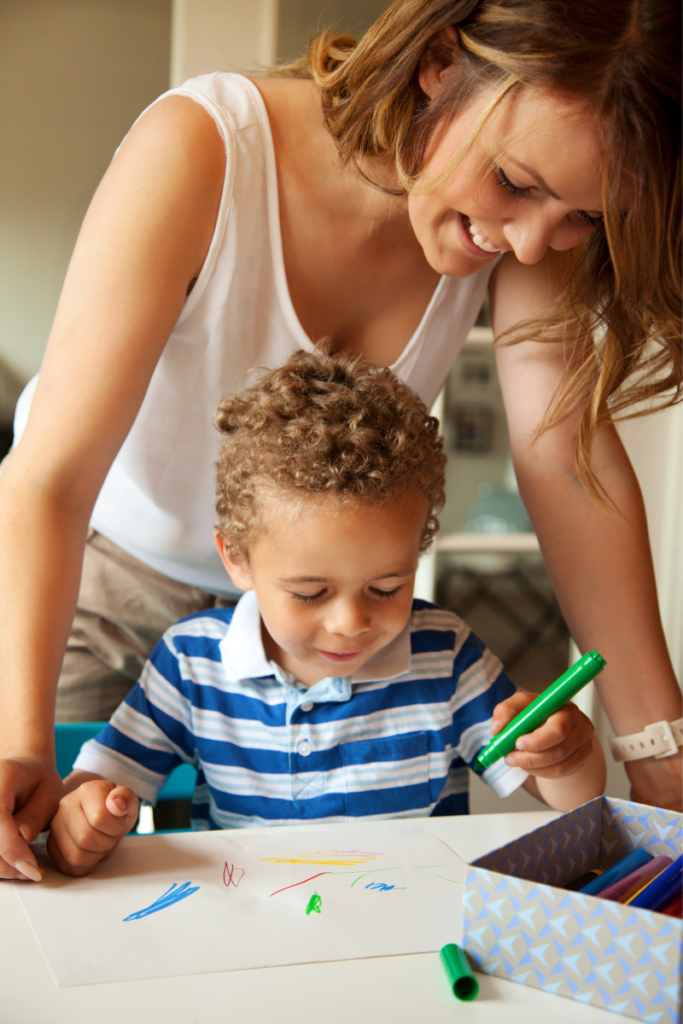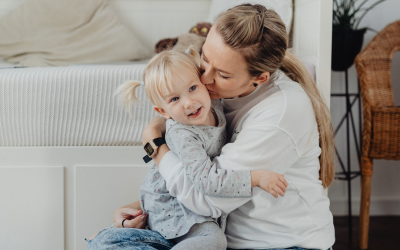Mom guilt is a common feeling that so many moms feel and stems from societal pressure and expectations. However, it’s important to recognize the need to shift this guilt and bring awareness to our true feelings.
By understanding the roots of mom guilt and embracing emotional intelligence, we can break free from this cycle and create a healthier, happier environment for ourselves and our children.
We can bring more awareness to our true feelings and stop labeling them with this societal term. This allows us to overcome mom guilt and create a more positive and empowering mindset.

Understanding Mom Guilt
Mom guilt can arise in various situations, both big and small. For example, telling your kids they can’t have a snack a half hour before dinnertime might give you a small pang of guilt, but it’s relatively easy to shift these feelings. However, instances, when you can’t control the outcome, can trigger more intense guilt. Watching our children experience intense emotions like pain or loneliness may also contribute to those feelings. It’s important to recognize that mom guilt often stems from deep-rooted emotions and experiences unrelated to the present moment.
Recognizing Codependency
Much of the mom guilt we experience is rooted in codependency, where we internalize our children’s feelings as our own. We make their emotions about us rather than allowing them to be their own experiences. Mom guilt can also come from external factors such as broken promises from significant others, family members, or bullying. When we can differentiate between our children’s emotions and our own, we can create a space where both can coexist. By addressing our emotional needs and creating emotional intelligence within ourselves, we can model healthy behavior for our children.

The Impact of Emotional Energy
The energy we bring into a room affects not only ourselves but also those around us, especially our children. When we feel guilty, it expands into our environment and influences our children’s emotional well-being. If we want our children to live fulfilling lives free from guilt and self-blame, we need to be able to model this for them. We have the power to choose our own emotions and shift into them. Showing our kids how to do this too is an invaluable skill they’ll use for their entire lives. By acknowledging this ripple effect and recognizing the very real impact of guilt, we can make a conscious decision to change our emotional energy and create a more positive atmosphere for our families.
Embracing Emotional Intelligence
Increasing our emotional intelligence allows us to connect with ourselves and our children on a deeper level. It involves acknowledging and accepting our own feelings, allowing them to flow naturally, and understanding that experiencing emotions is a normal part of life. By modeling emotional intelligence, we provide our children with the tools to navigate their own emotions and develop healthy coping mechanisms. As moms, we carry a huge responsibility, and by nurturing our own emotional well-being, we can create a lasting impact on our children’s emotional development as well.
Moving Beyond The Regret Of Mom Guilt
Regretting past experiences or feeling inadequate from postpartum depression or anxiety is a common part of mom guilt. Instead of allowing these regrets to influence the way we parent now, it’s important to focus on the present moment and embrace the opportunity to make lasting changes. Letting go of regret and embracing self-assurance allows us to make decisions confidently, which benefits ourselves and our families. We can choose to be solution-oriented and embrace the choices we make while understanding that we cannot change the past.

Effective Communication and Setting Boundaries
Instead of simply saying “no” when our kids want something they aren’t able to have, we can explain the reasons behind our decisions. If they want a snack right before dinner, we can explain the importance of nutrition and offer healthy snack options instead. By engaging in honest and age-appropriate conversations, we allow our children to understand the purpose behind our choices and develop a sense of responsibility. This also creates boundaries which allow for more cooperation and understanding from everyone. When we provide an environment where feelings are expressed and understood, we enable our children to develop their own healthy emotional models of the world.
Modeling Emotional Expression
Becoming the aligned mama starts with embracing imperfection and allowing ourselves and our children to feel their emotions fully. When we free ourselves from the need to justify our decisions, we can instead provide our children with a better understanding of the world. As mothers, we have a profound impact on our children’s emotional development. By demonstrating the importance of expressing and processing feelings, we create a safe space for our children to do the same. Sharing our emotions openly and allowing our children to witness our growth and vulnerability promotes their emotional well-being and helps them to navigate their own feelings.

Conclusion: Mom Guilt
Mom guilt is a common feeling that many mothers face, but it doesn’t have to define our parenting experience. By recognizing the roots of mom guilt and embracing emotional intelligence, we can shift our mindset and create a healthier environment for ourselves and our children. Letting go of guilt, practicing open communication, and modeling emotional expression can lead to a more fulfilling and empowering journey of motherhood. Shifting our perspective on mom guilt involves embracing our authentic feelings, creating emotional intelligence, and setting an environment where open communication and understanding are key. By taking the initiative to release guilt, set boundaries, and prioritize emotional well-being, we empower ourselves and our children to live fulfilling lives free from unnecessary shame and guilt.
